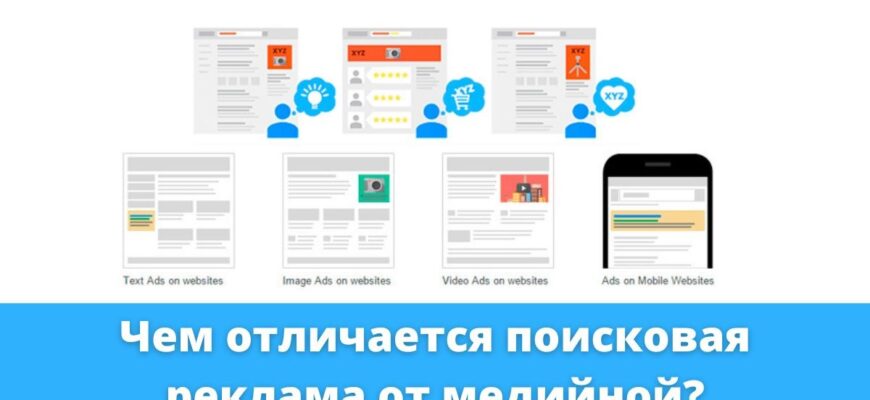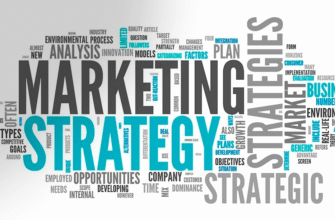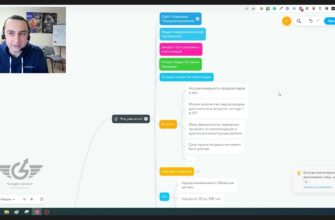- What is search contextual advertising?
- What is media advertising?
- Advantages of search advertising
- “Hot” audience
- High CTR
- Higher level of audience trust
- Easier setup
- Faster results
- Disadvantages of advertising in search
- Expensive click
- Not suitable for niches with unformed demand
- Pros of contextual-media advertising
- It helps create demand
- Broad coverage
- Raises brand awareness
- Low cost per click
- Minuses of advertising in KMC
- There is no clear intent
- “Cold” audience
- Low CTR
- What is the difference between search advertising and media advertising?
- Which is better to choose, search engine advertising or media network advertising?
Today, any business is faced with a huge choice of information channels and promotion strategies. The two most popular options are search advertising and contextual media network advertising. Both of these tools have their unique advantages and are capable of increasing reach, generating leads and company profits.
Many marketers and business owners wonder which of these tools to choose. What are the differences between search and media advertising? Is it worth investing money in one of them or use both at the same time?
To make the right decision and develop the most suitable strategy for you specifically, it is better to understand in more detail the specifics, strengths and differences of search advertising or advertising in the contextual-media network.
How many calls and sales will I get by ordering contextual advertising from you?
I need to calculate the conversion of my website Describe
the task
in the application
Calculate potential ad revenue Google
contextual advertising calculator
What is search contextual advertising?
Search advertising can be seen in the output of Google and other search engines before the organic output and after it. It allows you to attract the most “hot” audience, because it is shown to users at the very moment when they are in search of goods or services related to your business.
The popularity of search advertising is due to its high efficiency and the possibility of accurate targeting. According to the report of the Internet Advertising Committee of the IAU, in 2023 its share of the e-commerce market in Ukraine amounted to an impressive 63%. Ukrainian advertisers invested in it about UAH 8 billion out of UAH 12 billion invested in Internet marketing.
These ads are shown in response on search engine results pages in response to keywords entered by the user:
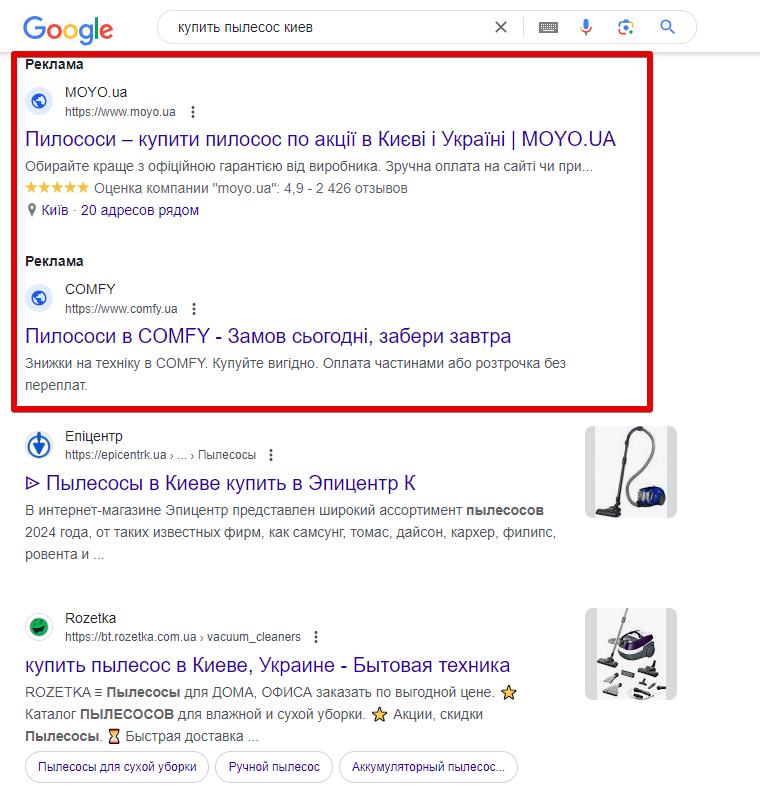
The ads are placed in the first positions above the organic output and are marked with a black “advertisement” bar. These are standard blue links leading to pages on the advertiser’s website. Additionally, such ads can include extensions (company address, phone number or links to specific sections of the website), which increases their informativeness and attractiveness.
The main point in optimizing a search campaign is to choose the right key phrases for which your target audience will be looking for information online. Search engine algorithms analyze queries and select the most appropriate advertising messages to be displayed next to the organic output.
What is media advertising?
Media advertising is shown to the audience not by the search engine, but by third-party sites that are part of Google’s extensive network of partners. These resources are popular information and news portals, entertainment sites, video hosting, mobile applications and other platforms.

It looks attractive and varied compared to the usual text – visual elements (images, animation, video or interactive banners) are used here. This allows you to capture attention and stand out against the background of boring content.
These ads open up more opportunities for creativity and visual communication with the audience. With the ability to experiment with different formats, test different images, texts and calls to action, it is much easier for advertisers to find an effective combination for a particular CA.
Advantages of search advertising
Each of the tools described above has both its pros and cons. The use of one or another of them depends on the specific objectives of the advertiser. First, let’s talk about the advantages of advertising in search.
“Hot” audience
The very principle of search contextual advertising assumes the presence of a certain “context”. That is, the user already wants to buy a particular product (good or service) and is simply looking for where to do it. This approach is called “demand harvesting” because you are literally harvesting the existing demand for your services.
For example, if a visitor enters the phrase “carpet dry cleaning” in a search engine – there is a chance that a person is interested in the corresponding service specifically at the moment. And your advertising will be shown to such a client at exactly the right time.
However, not all keywords are “equally useful”. Some of them have more commercial value in comparison with others. For example, phrases that contain the words “order”, “buy” or describe products in detail, attract the most “hot” visitors. But the keywords that contain “inexpensive” or even more so – “free” already have a much lower priority for promotion.
Thus, showing contextual advertising in search for “hot” queries, you can immediately address the audience on the lower floors of the sales funnel, which is already ready to make a conversion, skipping the upper floors with a more “cold” customer base.
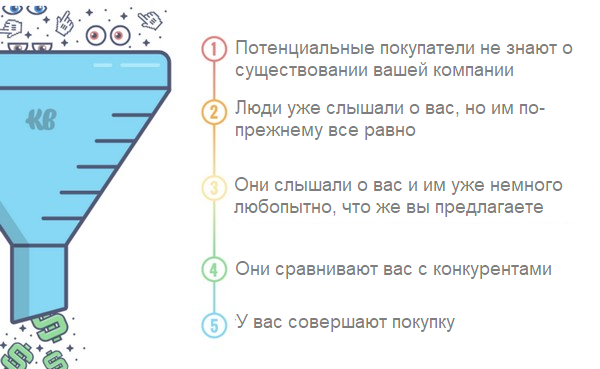
High CTR
Search advertising in terms of clickability has much better indicators in comparison with media. At the same time, the indicator can differ literally in times (in some topics, the CTR of search ads can reach 15%, while banners are usually clicked by less than 1% of the audience who viewed them). Of course, CTR strongly depends on the specific niche and other parameters (relevance of the offer, position, etc.), but still the difference is very noticeable.
Accordingly, the conversion rate from such transitions is usually higher. Users who have opened your site have already shown interest in it. This increases the likelihood that they will take the desired action, whether it’s ordering products, filling out a form, or making a call.
Higher level of audience trust
Many visitors can’t always tell the difference between context and organic search results (except for the small black lettering, text ads are no different from regular search results). Because of this, advertising links are often perceived as reliable and trustworthy sources of information.
Unlike brightly colored banners or video ads, which clearly stand out on the page and can often cause irritation or “banner blindness”, visually simple and clear texts look organic and are not perceived as something intrusive.
Easier setup
To launch an advertising campaign, you will not need to hire a designer or spend resources on creating complex creatives. It is enough to write relevant and attractive texts by yourself, having selected popular search words through the free service “Google Keyword Planner”.
All these steps can be performed by yourself in the convenient interface of Google Ads, even if you don’t have money for a PPC specialist, designer or videographer. But with media ads, launching a campaign will be more complicated and, importantly, more expensive.
Faster results
Advertising in search allows you to get the first inquiries from potential clients in the shortest possible time. If the campaign is set up correctly, the first requests can come as soon as a few hours after the launch.
Thanks to this, such advertising is suitable for situations where you need to attract customers quickly, for example, when launching a new product, time-limited promotional offers or testing demand for services.
You can quickly assess the effectiveness of advertising, get the first leads and start working with them, optimizing the campaign along the way to achieve even better results.
Disadvantages of advertising in search
Despite all the advantages described above, advertising in search has some disadvantages that should be taken into account when preparing an advertising strategy. After all, this tool is not suitable for any niche and, importantly, not for any audience.
Expensive click
The high cost per click is especially acute in niches with high competition. As the popularity of PPC grows, so does the competition for audience among advertisers. This leads to a constant increase in the price of a click and a decrease in the return on investment.
Google Ads works on the principle of an auction, and the more people participate in it, the more expensive it is to click on a particular query. Competitors in different niches are trying to outbid each other in order to take the best positions in the paid rendition and get as much traffic as possible. The more competitors fight for presence in search for the same keywords – the more expensive a click is.
How many calls and sales will I get by ordering contextual advertising from you?
I need to calculate the conversion of my website Describe
the task
in the application
Calculate potential ad revenue Google
contextual advertising calculator
The high cost of clicking through to the site becomes a serious barrier for small and medium-sized businesses whose budgets are very limited. Even if a PPC specialist has selected relevant key phrases and creates attractive offers, advertising may not be profitable for businesses in overheated markets due to competition with larger players.
Not suitable for niches with unformed demand
Search advertising is primarily aimed at people looking for information directly related to the products or services you offer. But if your product is a new product that has not yet been introduced on the market and people are not yet aware of its existence, this tool will definitely not work.
To promote products or services with unformed demand, media advertising or targeted ads in social networks (Facebook, Instagram, TikTok, etc.) will work much better.
Pros of contextual-media advertising
Unlike ads in search, customized for people who already come with a certain intention and are actively looking for information, advertising in the contextual-media network allows you to reach “cold” traffic – those who have not yet thought about buying, but could potentially become your customer. And this tool is also highly effective, just for a different kind of task. It has the following benefits.
It helps create demand
PBC media advertising appeals to people who have not yet considered buying, but have an interest in topics related to your niche. They may read blog articles, browse themed sites, or participate in forum discussions. By placing your ads on such sites, you get the opportunity to “warm up” a cold audience and form a need for your products or services.
For example, you have your own barbershop and you want to attract customers to the site. Articles like “10 Best Men’s Haircuts” or “Popular Beard Care Oils” are great for promoting your services. Readers of such articles are clearly looking after themselves and visiting a barbershop now or planning to do so in the future.
However, it’s important to realize that at this stage, people are likely not yet ready to call and book a master for a specific time. Aggressive calls to action like “Leave a request now” may be ignored or even cause irritation.
Instead, you can suggest subscribing to the company’s social media accounts, where you publish useful posts and examples of your work. This will help establish a first contact with potential clients, give them a chance to familiarize themselves with your expertise and encourage them to interact further, gradually fueling interest.
Broad coverage
Media banners reach the widest possible audience, even if they are not directly interested in your offers. Your ads can appear on thousands of partner sites, mobile apps and even YouTube.
According to Google, the network reaches over 90% of internet users worldwide. Thus, that your offer will be noticed by a huge number of potential customers, many of whom may not even realize they need your products until they see an advertisement.
Of course, you shouldn’t expect instant sales from such a wide reach. It primarily works for prospects, building knowledge of the company among a wide audience. But the more people know about you, the higher the chances that they will remember your brand when they have a need for similar products.
Research shows that people often need more than one contact with a brand to make a purchase decision – and PBC helps provide those contacts.
Raises brand awareness
Bright, eye-catching images and important benefits of your offering can help you stand out from the competition and be remembered by future customers. This works especially well when launching a new brand or launching a new product.
Imagine opening an innovative chain of coffee shops where visitors will not only enjoy hipster coffee, but will also be able to work in a cozy co-working space together with people with similar interests and lifestyles.
In this case, creating a series of colorful image ads to be displayed on websites about coffee culture, remote work and freelancing will help. Even if people don’t click right away, they will start to recognize the brand when they see it again on online sites or on a billboard near their home.
Low cost per click
In most niches and topics, the price per click in the contextual media network will be noticeably lower than in search advertising.
This is due to the fact that in CMMS, as a rule, the level of competition is lower, as not all advertisers understand the capabilities of this tool and prefer to work exclusively with a “hot” customer base.
A lower click price in the media network does not mean lower efficiency. Even with a greater number of impressions and clicks, conversion from media is usually cheaper than from search.
Minuses of advertising in KMC
Despite all the above pluses, is not devoid of advertising in KMC and certain disadvantages, like any other tool. Let’s talk about them further.
There is no clear intent
The audience here is more passive. People are in the mood to simply read news on the site, use the mobile application or play a game on a smartphone, without thinking about purchases. Thus, advertising in KMC is not suitable for all tasks and requires a special approach.
If in search ads you can appeal to customers with appeals “Buy now” or “Book at a discount”, in KMC it will cause an exclusively negative reaction. Only unobtrusive, informative ads that offer additional value to people, but not directly the product itself, are valid here.
“Cold” audience
Banners will be seen by people who are not yet aware of your brand and are not interested in your products or services. They are at the very top of the sales funnel, so you need to first arouse their initial interest and then “warm them up” for further interaction.
Thus, a lot of orders and conversions should not be expected from here. Set yourself up for the long game and further hard work with your audience. Focus on building relationships gradually. To do this, you can use a series of ads and connect remarketing to remind you and nudge users to the next steps in the funnel.
Low CTR
According to Google, the network includes more than 2 million partner sites and applications, allowing you to reach almost any internet user. Thus, your ad will be shown to a huge number of people. However, not all users who see the ad will be interested in it enough to go to the site.
As a result, the CTR in media advertising is usually much lower than in search advertising. The average clickability here often does not exceed 0.1%. This means that there may be only 1 click per 1,000 ad impressions. Of course, this figure varies greatly depending on the topic, ad quality and targeting settings, but in general, low CTR is the norm for media.
What is the difference between search advertising and media advertising?
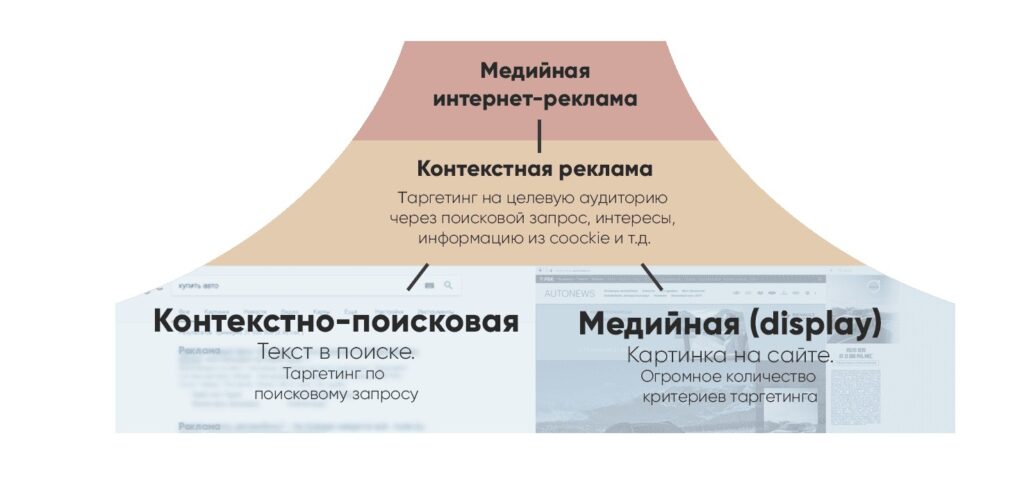
The main differences between media advertising and search advertising are as follows:
- Purpose. Search advertising will help to increase the number of orders and conversions on the site, but the banner works at the upper stages of the funnel. Its purpose is to increase brand awareness, interest more people, inform about new products or promotions.
- Format. If the ads in the search engine is a small text plus a link to the advertiser’s site, then in CMC more diverse formats are used – banners with images, videos, etc. The main emphasis is on the visual component and creativity, which should attract attention and arouse interest.
- Targeting. For contextual media network you can target your ads to your audience depending on what sites they have visited before, their interests, behavior, income level. For search this is impossible, segmentation here is much broader.
- Payment model. For search advertising there is a pay per click or pay per display model available. The CPC (Cost Per Click) model, which involves payment for clicks, is more popular. But in media advertising, payment is made only according to the CPM model. The advertiser pays a fixed amount per 1000 impressions, regardless of the number of clicks.
- Minimum budget. Ads in the search engine are effective even with small investments, if the keywords are chosen wisely. In Google Ads the minimum campaign budget can be 2000 UAH per month (for topics with little competition). For success in CMC, as a rule, much higher costs are needed. It makes sense to start a campaign here with a budget of at least 10000 UAH per month. With smaller investments the effect will be hardly noticeable.
- Place in the sales funnel. Media influences users at the initial stages of the funnel. It does not sell directly, but introduces the brand and builds an image. Therefore, its task is to build up coverage, increase recognition and loyalty, which are designed for the future. And search intercepts demand when people already have a need for a product and are looking for exactly where to order it. Therefore, it shows good results for stimulating orders here and now.
Which is better to choose, search engine advertising or media network advertising?
So what to choose after all, search engine advertising or media network advertising? This question is asked by many business owners and even professional Internet marketers. But there is no unambiguous answer here.
The choice depends on many factors that need to be taken into account when planning an advertising campaign:
- Level of brand awareness. If your brand is still little known and you need to increase its recognition, then KMC is exactly what you need. Non-standard advertising formats will help to attract the attention of those who do not yet know about your company. But for those who have been on the market for a long time, search is better. It will provide a faster return on investment, and also copes well with the stimulation of repeat sales.
- Keyword Popularity. If in your niche buyers use high-frequency and commercial – then search advertising is better. It will allow you to be on the first positions on the most “hot” keywords and intercept traffic from competitors.
- Type of promoted product. Media is suitable for promoting tangible goods, especially image products. Photos and videos help to demonstrate the product from a favorable side, evoke emotions and the desire to buy. This is relevant for clothing, footwear, accessories, electronics, cars, furniture, household goods. But for services (especially urgent ones), it is better to use an alternative. When a person needs a plumber, a tow truck or a dentist, he enters the appropriate query in the search and opens, as a rule, no more than 3-5 first results. A banner at this point will only distract attention.
- Type of device used. Bannerka performs especially well on mobile devices. Smartphones today have become the main screen for content consumption, and mobile applications are the main source of traffic. In addition, smartphones usually do not have AdBlock installed, which has a positive impact on overall reach.
Thus, there is no universal answer to the question of which ads are better. Each of them solves its own tasks and operates at different stages of interaction with the client. One helps at the beginning of the funnel, while the other helps at the end.
The ideal is to take an integrated approach and combine both channels depending on your campaign goals and budget. Start with small budgets on both channels, evaluate the first results and reallocate funds in favor of the option that works best. Gradually you will find the optimal mix of traffic sources for your business.

